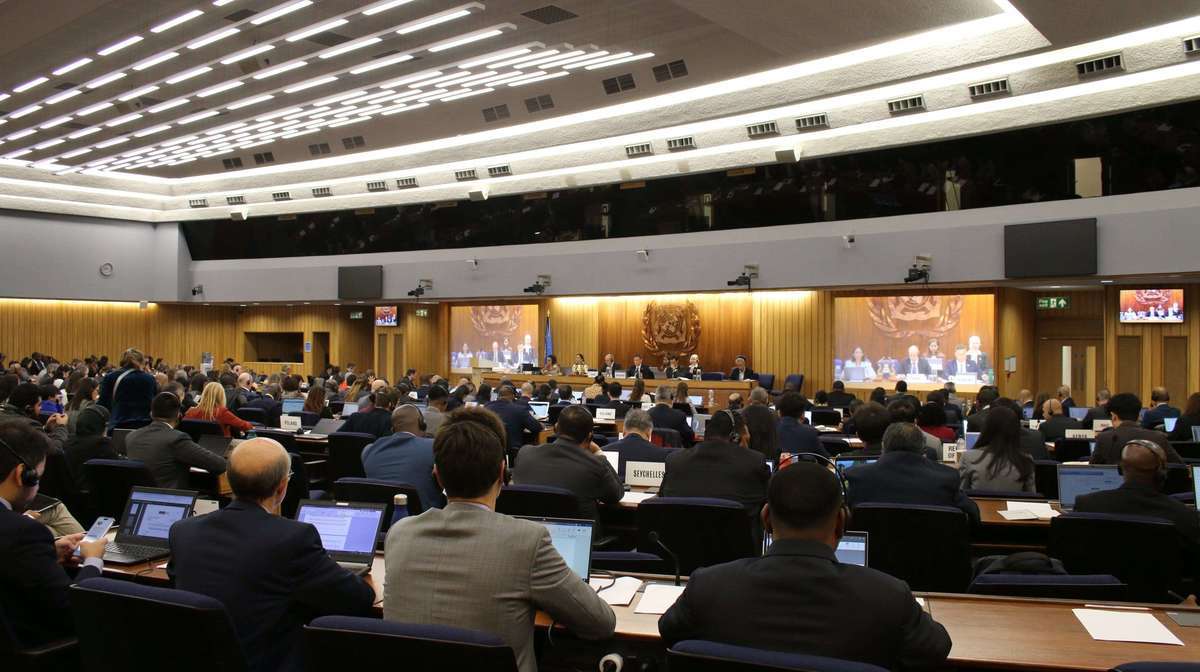The Week in Alt Fuels: The final countdown
In a movie, this would be the moment before the final act, when the outcome depends on a single decision. Next week, the IMO must choose between progress or another missed opportunity.
 IMAGE: Representatives from member states at the IMO’s Intersessional Working Group on the Reduction of GHG Emissions from Ships meeting in London. X of @IMOHQ
IMAGE: Representatives from member states at the IMO’s Intersessional Working Group on the Reduction of GHG Emissions from Ships meeting in London. X of @IMOHQ
Correction: An earlier version misstated how many IMO member states would need to be flipped to block adoption. Only MARPOL Annex VI signatories can vote next week and two-thirds of voting signatories are needed for adoption.
Many have already made their case for why adoption next week matters and why the IMO must hold its course.
The stage is set. Shipowners are increasingly ready. Ports are willing. Fuel producers are emerging. Interim safety guidelines are in place.
The global LNG-capable fleet is projected to reach 1,417 vessels by 2030, according to DNV. The methanol-capable fleet is set to number 437 vessels, and the ammonia-capable fleet 41 vessels.
LNG and methanol bunker operations have already begun across major ports, from the EU to Asia and the US. China’s Dalian port has pioneered ammonia bunkering. Singapore and Australia’s Pilbara plan to demonstrate ammonia by 2026 and Rotterdam by 2027.
Fuel producers are equally poised. More than 250 green methanol projects are under development worldwide, with major volumes expected by 2027–2028, the Methanol Institute (MI) said. DNV data shows that 65-70 million mt/year of combined green and blue ammonia capacity could also come online through 2027.
But MI notes that while existing methanol supply can meet current demand, scaling production for shipping will require uniform global regulations to prevent costly regional fragmentation. This warning equally applies to ammonia.
Interim IMO guidelines for using methanol, ammonia and hydrogen as bunker fuels have also been finalised. Revisions and supplementary codes are still needed, but this is a start.
Ports have moved from discussion to demonstration. Many shipowners have started ordering vessels that can burn alternative fuels and some have signed offtake agreements to fuel these vessels. But without a global framework to connect these efforts, technology could outpace policy.
If adopted, the IMO framework will introduce a global GHG intensity standard and a pricing mechanism, though clarity is still needed on lifecycle emission factors, feedstock criteria and incentives for overperformers.
If consensus slips, regional measures like FuelEU Maritime and the EU ETS will continue to set the pace.
But regional measures “currently do not support a globally just and equitable transition for the international shipping sector and key elements – such as consideration for the equitable distribution of revenue – are lacking to make these globally-effective and equitable measures,” Emma Fenton, senior director of climate diplomacy at Opportunity Green, told ENGINE.
What’s at stake? Fuel economics, fairness in who pays and who benefits, investment decisions and the fate of nations most vulnerable to climate change and rising seas.
Rocky Balboa once said, "It ain't about how hard you can hit. It's about how hard you can get hit and keep moving forward. How much you can take and keep moving forward. That's how winning is done!"
The same lesson applies to the IMO.
Next week’s vote won’t be about landing the perfect blow. It will be about whether a regulator can move forward despite resistance from fossil-fuel incumbents and whether two-thirds of Marpol Annex VI signatory member states that vote next week, vote in favour of the regulation.
“The diplomatic threats from the US are a disappointing but unsurprising element of the negotiations, given their interventions in April,” said Emma Fenton of Opportunity Green, “but we hope that the global solidarity demonstrated earlier in the year will be the basis for ambition and success at these coming negotiations.”
Next week will also test the IMO’s ability to stick to the timelines that matter and to decide whether the transition will be “just and equitable” for all member states.
Adoption will not end the story. Not even close. In fact, it will begin an uphill climb toward the IMO’s net-zero ambition, shaped by uncertainty, legal complexity and competing national interests.
But that uncertainty is not paralysis.
As the Ammonia Energy Association noted, the industry can work through the unknowns and “solve the technical, safety, operational, and strategic challenges once regulations establish the business case.”
And that moving forward despite uncertainty, that will be how real progress will be made.
In other news this week, global energy firm Shell has signed a time-charter agreement with Singapore-based maritime transport company Purus for two LNG bunker vessels. Each vessel will have a capacity of 18,900 cbm and will be built at China’s Nantong CIMC Sinopacific Offshore & Engineering, with delivery scheduled for 2028.
Danish methanol producer European Energy will use a technology developed by Germany’s SYPOX to produce biomethanol, with output expected from 2026 onwards. SYPOX’s technology will help lower biomethanol costs and reduce the fuel’s carbon intensity, the company said.
Japanese shipping company Mitsui O.S.K. Lines (MOL) has signed a memorandum of understanding with NH3 Clean Energy (NH3) and Oceania Marine Energy to develop ammonia bunkering at the ports of Dampier and Port Hedland. Under the agreement, NH3 will supply about 300,000 mt/year of blue ammonia, and Oceania will handle physical deliveries at the two ports. MOL will focus on vessel deployment and operational integration within the project.
By Konica Bhatt
Please get in touch with comments or additional info to news@engine.online






